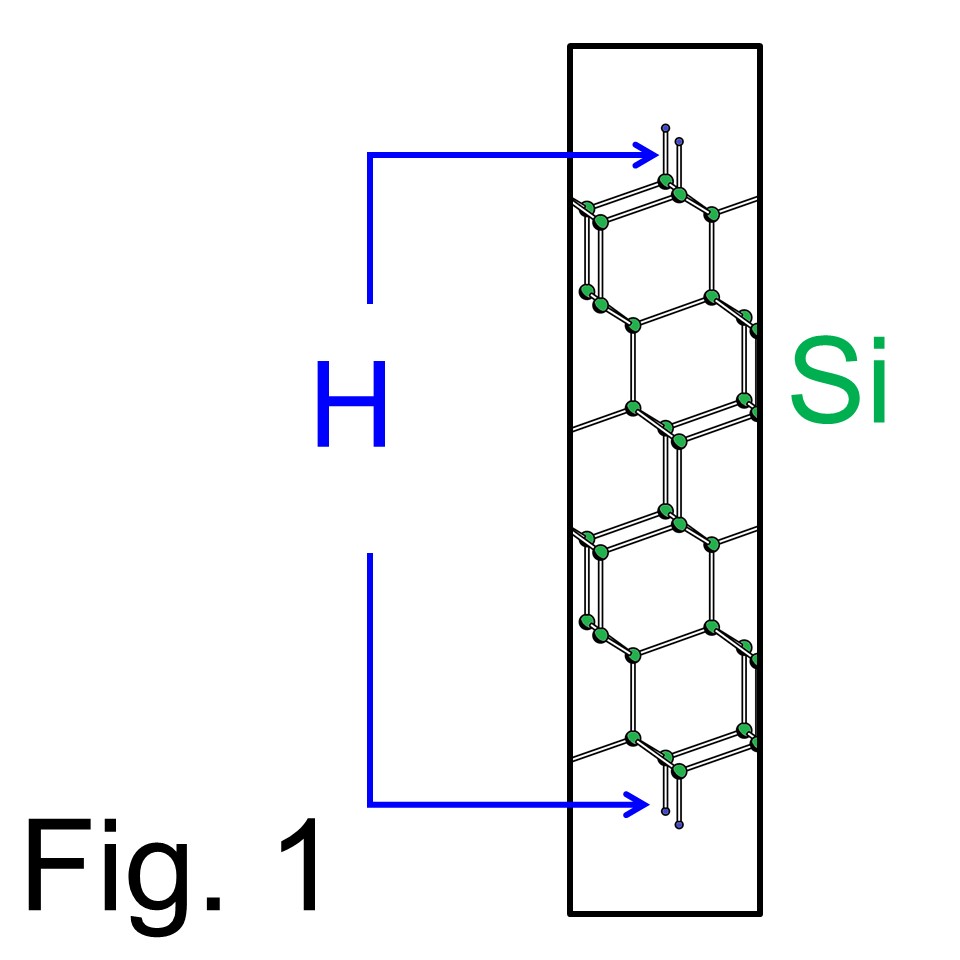How to run?
Run 'sd_exe' - the band structure calculation by steepest descent diagonalization
 Here the manual steps to 'sd_exe' with the same example. This guidance is written for people who already finish to run 'cg_exe. Those who have not finish to run 'cg_exe' need to back Run 'cg_exe'. (Those who have not made executable load modules 'cg_exe', 'sd_exe, and 'tddft_exe', need to go How to compile?.)
Here the manual steps to 'sd_exe' with the same example. This guidance is written for people who already finish to run 'cg_exe. Those who have not finish to run 'cg_exe' need to back Run 'cg_exe'. (Those who have not made executable load modules 'cg_exe', 'sd_exe, and 'tddft_exe', need to go How to compile?.)The example is the same as that in running 'cg_exe', see in Fig. 1, which is a Si(111) slab model terminated by H atoms on top and bottom. Here a band structure calculation with extended wavefunctions in full grid G-space is performed to make second-step toward the TDDFT calculations, which simulate laser-induced H desorption.
Since the structure shown in Fig. 1 is the same as that used in 'cg_exe', a tiny change in the input data is enough to run, which will be explained below the box. The change is tiny but very important to run 'sd_exe'. CD=ATOM becomes CD=FILE, WF=INIT becomes WF=FFT, and CG becomes SD.Furthermore, the letter FFTWF should be deleted. The changed part is highlighted by color and other parameters should be remained as they were. (This template file is obtained from download 'Si111-H_sd.in' with a new name 'Si111-H_sd.in')
%%% Si(111)1x1 H-term cell %%%%
STND KPOINT=MESH ALAT=4.4427103214141699 ZVAL=50 RCUT=845 GCUT=12.0
PP=(KB,SOFT) CD=
OUTWF=23 METAL=(25,0) KCONT=0
RMIX=0.03 CONV=1.D-7 MAXFN=0 OKSTEP=0.1D0/
1.4142135623730951 -0.8164965809277260 0.0000000000000000 A1 vector
1.4142135623730951 0.8164965809277260 0.0000000000000000 A2 vector
0.0000000000000000 0.0000000000000000 13.1042541360369356 A3 vector
2 Si12H2 # of Atomic types, chemical composition
12 2 28.0855 # of type 1 atoms, # of pseudo orbitals, atomic mass
0.0000000000000000 0.0000000000000000 0.0380725996019826 TAU( 1)
0.3333333333333333 0.3333333333333333 0.0628830683197726 TAU( 2)
0.3333333333333333 0.3333333333333333 0.1388370510257218 TAU( 3)
-0.3333333333333333 -0.3333333333333333 0.1638618412213989 TAU( 4)
-0.3333333333333333 -0.3333333333333333 0.2398223878715089 TAU( 5)
-0.0000000000000000 -0.0000000000000000 0.2642651909875856 TAU( 6)
-0.0000000000000000 -0.0000000000000000 -0.0380725996019826 TAU( 7)
-0.3333333333333333 -0.3333333333333333 -0.0628830683197726 TAU( 8)
-0.3333333333333333 -0.3333333333333333 -0.1388370510257218 TAU( 9)
0.3333333333333333 0.3333333333333333 -0.1638618412213989 TAU( 10)
0.3333333333333333 0.3333333333333333 -0.2398223878715089 TAU( 11)
0.0000000000000000 0.0000000000000000 -0.2642651909875856 TAU( 12)
-2 0 1.0 # of type 2 atoms (negative!), # of pseudo orbitals, atomic mass
-0.0000000000000000 -0.0000000000000000 0.3131888120278811 TAU( 13)
0.0000000000000000 0.0000000000000000 -0.3131888120278811 TAU( 14)
30.0 Rcut for LVGENX
4 total # of k-point mesh in one direction
1 1 0 starting points of k-point mesh for B1 B2 B3 vectors
2 2 4 skipping # of k-point mesh for B1 B2 B3 vectors
1 0 0 just these three lines
0 1 0
0 0 1
0 0 0
10 10 10 NDX NDY NDZ for DOS
2.0 2.0 for type 1 -- #s of electrons on s- and p-orbitals
1.0 0.0 for type 2 -- #s of electrons on s- and p-orbitals
Same as the input data for 'cg_exe',
The files 'size.dat', 'sym.C1' and pseudopotentials are the same as those used in running 'cg_exe'. All of these have specific numerical format suitable only to FPSEID21 package.
Here is an example of a script file to run 'sd_exe' which show tiny change from that of 'cg_exe'. The changed part is again highlighted in red font. At file I/O FORT22, the name of files changed from 'wf.Si111-H'' to 'wf_fft.Si111-H' which is input file of wavefunction represented in full grid in G-space. But this input file is rarely used since 'sd_exe' usually reaches SCF convergence immedietely from wavefunction in real space grid. At file I/O FORT23, the name of file changed from 'wf.Si111-H_new' to 'wf_fft.Si111-H_new' At the last line, the name of module changed from 'cg_exe' to sd_exe' as well as subsequent input and output files with their changed names as 'Si111-H_sd.in' and 'Si111-H_sd.out', respectively.
#$ -N sd_exe_Si111-H-1x1H
#$ -S /bin/bash
#$ -j y
#$ -e /home/youraccount/Si111-H/std_omp.err
#$ -o /home/youraccount/Si111-H/std_omp.out
#$ -pe mpi 16
export DIR=/home/youraccount
export DIR2=/home/youraccount/Si111-H
### --- input files
### pseudopotentials
export FORT41=$DIR/TR/TR.Si93g_asci ! Si Pseudopotentials (g)
export FORT46=$DIR/TR/TR.Si93e_asci ! Si Pseudopotentials (e)
export FORT42=$DIR/TR/TR.H99g_asc ! H Psedutopotentials
###
export FORT54=$DIR2/size.dat
export FORT55=$DIR2/sym.C1
###
export FORT20=$DIR2/rh.Si111-H ! input charge when 'CD=FILE' in 'Si111-H.in'
export FORT22=$DIR2/wf
### --- output files
export FORT23=$DIR2/wf
export FORT88=$DIR2/wf_real.Si111-H ! input wavefunction (real space) used by 'sd_exe'
export FORT90=$DIR2/Vall.Si111-H
export FORT24=$DIR2/rh.Si111-H_new ! output charge density
export FORT25=$DIR2/Vint.temp
export FORT77=$DIR2/tau.Si111-H_new ! atomic coordinate stored at the end of 'sd_exe'.
export FORT78=$DIR2/need
export OMP_NUM_THREADS=4
cd $DIR2
$DIR/lm/
To judge whether SCF solusion was obtained, please do
$ grep ITR Si111-H_sd.out
Then values of the convergency are listed which must reach below the value of criteria 1.D-7.
After reaching the convergence, the output files 'rh.Si111-H_new' and 'wf_fft.Si111-H_new' are charge density and wavefunctions that are initial conditions of the TDDFT calculation. To move to next step for TDDFT simulation, click the icon below.